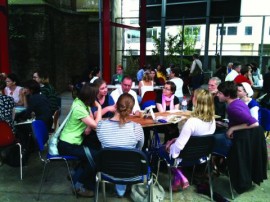
Change, possibility and expectance
The British Art Show (BAS) returns to Nottingham five years on for its seventh manifestation, only this time Nottingham plays host as the launching city and the show has a subtitle – ‘In the Days of the Comet’.
The British Art Show (BAS) returns to Nottingham five years on for its seventh manifestation, only this time Nottingham plays host as the launching city and the show has a subtitle – ‘In the Days of the Comet’.
With bids starting at just £200, the UK’s first Chinese contemporary art auction aims to be accessible both to established collectors and those looking to start a collection.
Polly Morgan, Morning, taxidermied robin, plate glass, 2007.
Throughout this year the nation’s attention has been focused first on the prospect of a new government, and then on the shifting messages emanating from the resulting coalition – messages about how we are expected to address the nation’s debt alongside visions of a ‘Big Society’ and coupled with swingeing cuts to public services.
Having worked in the public realm since 2004, I regularly consider who is my primary audience when curating a project.
It’s a peculiar sign of the times that the announcement by the Arts Council of Wales at their annual conference today of a 4% cut to the arts over three years was greeted by the audience of arts professionals with enthusiastic applause and pats on the back all round for securing such a good settlement from the Wales Assembly Government.
“Things are always changing
So don’t be sad and blue
Change can make you happy
‘Cause it brings you something new”.
(Lyric © Sesame Street)
Steve Dutton reflects on the exhausted Biennial model and gives his account of how curators are finding ways to overcome this syndrome.
This year’s visual arts recipients of the Paul Hamlyn Foundation Awards for Artists are Angela de la Cruz, Luke Fowler, Christina Mackie, Ben Rivers and Lindsay Seers.
Contents include: Studio and workshop facilities profiled in ’Space to create’; ’Partners in art’ looks art local authority arts organisers needs; artists Bruce Gilchrist and Jo Joelson and curator Emma Underhill discuss the Spontaneous City in the Trees of Heaven project in […]
Report from PARADOX – The Fine Art European Forum, Accademia di Belle Arti, Palermo, 21-22 September 2009.
Giulia Ricci, Untitled, hand made drawing, pen on paper, 25x20cm, 2010.
Su Blackwell, Gondol (detail).
Commentary arising from research into local authority arts organisers’ needs, aspirations and modus operandi, revealing how they value and engage with artists and the approaches they take to their own professional development and to supporting the environment for contemporary visual arts.
Profiling studio and workshop facilities around the country, plus ambitious exhibition projects that are engaging with local communities.
Artists Bruce Gilchrist and Jo Joelson and curator Emma Underhill discuss their collaboration on a project to create a sculptural ‘habitat’ that will contribute to the life cycle of birds in two urban garden locations.
Once upon a time, bohemians were considered a sub-culture, an alternative group of individuals moved by lifestyle choices and artistic endeavours.
Turning point, Visual Arts UK, CultureForum, NALGAO – these are just some of the burgeoning peer networks for arts professionals that have been proactive and visible in the arts funding debates.
Artists Studio Company has launched a major new public gallery in Southwark.
The Photographers’ Gallery officially closed its doors to the public for one year on 19 September 2010 to “embark on our ambitious development of the building, creating a new, international home for photography in the UK”.
This month’s bites.
Engage/Enquire’s ‘The Art of Influencing Change, Economies and Ecologies’ at Towner Art Gallery, Eastbourne and NALGAO’s annual conference in Brighton.
Two north west projects are creating links between artists, artist-led groups and creative communities.
Comings and goings amongst arts professionals and curators, designed to aid networking and collaboration.
One of the things that makes digital media so exciting is that they problematise many naturalised systems and spaces of communication.














